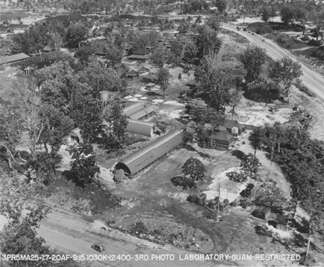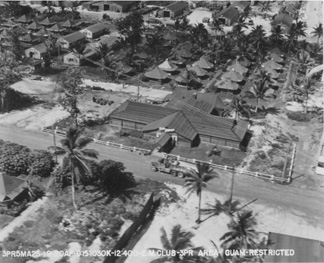The Story Of One Of The 91st SRS COs,
|
||||||
| My next mission from Saipan a few days later with a new #3 engine was quite different. M/Gen “Possum” Hansell, the 21st Bomber Command head was approving every recon mission. When I went to his headquarters to brief him on our planned route, which was to obtain an IP (Initial Point) to target run from Hamamatsu (on the Honshu coast southeast of Nagoya) to Nagoya, our planners had planned to take advantage of the jet stream that at our high altitude traveled west to east at 100 knots plus. Captain Doug Steakley and our early recon missions had “found” the jet stream. We planned to coast-in over the western part of Shikoku Island, pick up several targets in the Kobe–Osaka area and fly the IP target run from Nagoya to Hamamatsu on a south easterly heading as we departed. The General insisted that we do it his way-- from Hamamatsu to Nagoya. I pointed out to him that it did not make any difference to the cameras whether they were coming or going, but I lost the argument and we flew it his way. As it turned out, we were sitting at 33,000 feet over Hamamatsu, crabbed 45 degrees into the wind and moved practically nowhere for three minutes. We started moving forward but it took us almost an hour to fly the roughly 100 miles to Nagoya with heavy but fortunately inaccurate flak all around us. While on Saipan, we endured several Japanese bomber attacks from twin engine Bettys flown from Iwo Jima that destroyed several B-29s and one of our F-13s. The balance of our F-13s and crews continued to arrive. By the middle of December, Guam was declared secure and we prepared to move to Guam that would be our home for the rest of the war. On December 15th, Capt. Harold Wood and I each flew two flight crews, two ground crews and a jeep in each of our bomb bays to Guam with the mission of building a tent city for our 1,000 men by the first of the year. |
||||||
 |
||||||
|
area on Guam.
|
||||||
 |
||||||
|
|
||||||
 |
||||||
|
|
||||||
| We had aboard also, the $300 worth of power tools and most of the $1,000 worth of whisky (described in another story on this web site).The marines had a Japanese soldier treed in a palm in our area the day of our arrival on Guam. The Navy Construction Battalions, (C.Bs or Seabees) were building our quanset hut laboratory, mess hall, operations, maintenance and administrative buildings. We set up a production line and built with the power tools, the wooden foundations, siding uprights and rafters. The lower part of the walls were burlap covered and the upper part cover with mosquito netting. We placed 12'x12' squad tents on the rafters with a cupola dome on top. Our power tools made the work easy and the whisky enabled us to obtain enough lumber and tents to keep the production line on schedule. We were competing with many other units for the lumber and other building materials coming into Guam by ship. Fortunately, our living area was on the island highway between the docks and the Corps of Engineers lumber yard. If our daily allocation of lumber was inadequate to keep our production line going full blast, a bottle of whisky waved to a lumber truck on its way to the lumber yard provided us with the necessary lumber for that day. Editors Note: As referenced in Chapter 6, the details of this part of the story are found in a related section of this web site under the title “Then the Whiskey Started to Come in Handy, A story from the life of Clarence E. Becker”. If you choose to read those details at this time, click here and use your back button to return for continuity with the Becker biography. |
||||||
| The rest of the squadron moved down to Guam from Saipan in early January 1945 to our new home. Our aircraft hard stands, operations, maintenance and camera repair quonset huts were at Harmon Field about a half mile away from our living quarters, mess hall, photo lab and administrative area.. M/General Curtis LeMay took command of the 21st Bomber Command of the 20th Air Force replacing M/Gen Hansell when M/General LeMay arrived with his staff from India later in January. Harmon Field was close to his new headquarters. The field had only a 6,000 ft. runway with a 300 or so foot gradual rise in the terrain after take off. |
||||||
 |
||||||
|
“Double Exposure” Tom is looking out of the cockpit window and his co-pilot 1st Lt. John Pietsch is on the ground. |
||||||
| We could not safely take off for Japan with a full gasload, so we flew our planes to North Field (now Andersen AFB) just a few miles north that had a 10.000 foot runway plus a coral overrun that ended with a few hundred foot drop to the ocean It gave us, in essence, the safety we needed and a test hop for every plane before each mission. Our crews would be briefed about 2PM and then fly their planes with a light fuel load to North Field. The crews were bussed back to their quarters while the planes were fully fueled and serviced for their night take offs. The crews were awakened about midnight, fed and bussed back to North Field. After completing their missions, the planes landed back at Harmon, the film sent to the photo lab, the crews debriefed and the maintenance cycle restarted to ready the planes for their next missions. |
||||||
|
Or go to Chapters 1 — 2 — 3 — 4 — 5 — 6 — 7 — 8 — 9 — 10 — 11 Cover Page — Introduction — Table of Contents Or you may go to Home - Contact Us - Cold War Hist. - 91st SRS Hist. - Stardust 40 Mission Story |
||||||